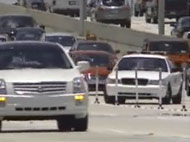7/13/2008
Florida HOT Lane Experiment Creates Safety HazardAccidents skyrocket on the day that toll lanes are introduced on a Florida interstate freeway.

The Friday debut of a High Occupancy Toll (HOT) lane experiment in Florida was marred by accidents and confusion. More than $35 million in federal gas tax dollars were used to create the "95 Express" project that converted existing High Occupancy Vehicle (HOV) lanes in toll lanes on Interstate 95 between downtown Miami and Fort Lauderdale. The lanes were opened Friday for free while officials tested the systems involved. The project's final cost is expected to reach $264 million.
"Look, it's unfortunate that there were three major accidents along the corridor today," Florida Department of Transportation project manager Debora Rivera told the Miami Herald. "Not to minimize the impact this had -- there were injuries, there was property damage, there were thousands of people inconvenienced by this. But some of this is to be expected."
Friday saw, essentially, a doubling in the number of incidents, as compared to an average day before the HOT project began. Two victims had injuries so serious that they were taken to a local hospital by helicopter.
The Florida DOT narrowed existing freeway lanes from twelve to eleven feet and eliminated a sizable amount of shoulder space to make room for the tolling lanes and necessary tracking equipment. Flexible plastic pylons were then used to separate paid traffic from the slower moving free lanes, limiting access into and out of the HOT lanes. Although the reduced space meets all minimum federal requirements, it provided less room for maneuvering as confused drivers made bad choices about how to reach their exits.
Some drivers weaved around or drove right through the barriers to make their exit in time. WSVN television cameras even caught a Miami police cruiser driving past the plastic barriers so the officer could make his exit.
Florida is not alone in discovering the potentially dangerous side effect of tolling. In April, a similar increase in the number of collisions accompanied the introduction of electronic toll lanes in Houston, Texas. Although officials assert that these problems will go away once drivers are accustomed to the new lanes, a 2005 Texas Transportation Institute study of HOV lanes suggested otherwise. It found that injury accidents increased by as much as fifty percent when high-speed traffic lanes were placed next to slower general purpose traffic without a concrete barrier in between.


